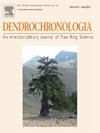Tracing aphid infestations through wood anatomical markers: Insights from Rhododendron campanulatum D.Don of the Himalayan region
IF 2.3
3区 农林科学
Q1 FORESTRY
引用次数: 0
Abstract
Recent climatic shifts have led to a noticeable increase in temperatures across the high-altitude ecosystems of the Himalayas, particularly in winter. This warming is altering growing conditions for many species, including aphids, found at higher altitudes where they were previously rare. As air temperatures increase, aphids develop more rapidly, extending their active periods and winter survival, and changing their geographical distribution and abundance. In this study, we analyzed the anatomical structure of Rhododendron campanulatum D.Don tree rings to detect aphid infestations in the higher elevational range of the Himalayas. Microscopic examination of wood sections from branches and increment cores from the main trunk revealed sapwood alterations caused by aphid activities. Our findings indicate that aphid activity was observed at elevations ranging from 3100 to 3400 m a.s.l., with a marked preference for younger trees (≤ 22 years) over mature ones (> 22 years) beyond a certain developmental stage. This suggests that aphid infestations are significantly more frequent and severe during the early life stages of the host trees, highlighting a vulnerability in younger individuals that diminishes with age. Hence, the pattern of aphid infestation is influenced not solely by rising temperatures, as previously assumed, nor is it significantly affected by altitude changes. Instead, it is notably impacted by the age of the samples. These anatomical markers highlight the impact of aphids and broader ecological shifts affecting plant resilience and forest health. Thus, this study urges collaboration among wood anatomists, entomologists, and ecologists to understand aphid life cycles, host preferences, and ecological interactions in the Himalayas. These findings are crucial for biodiversity conservation in the region and could affect ecological management strategies in other mountain regions worldwide.
用木材解剖标记追踪蚜虫侵害:来自喜马拉雅地区钟状杜鹃的启示
最近的气候变化导致喜马拉雅山脉高海拔生态系统的温度明显升高,特别是在冬季。这种变暖正在改变许多物种的生长条件,包括蚜虫,它们以前在高海拔地区很少见。随着气温的升高,蚜虫的发育更加迅速,延长了它们的活跃期和冬季生存期,并改变了它们的地理分布和丰度。本研究通过分析钟状杜鹃(Rhododendron campanulatum D.Don)树年轮的解剖结构来检测喜马拉雅地区高海拔地区的蚜虫侵害情况。对主干枝条和增量木芯的显微检查显示,蚜虫活动引起了边材的变化。我们的研究结果表明,在海拔3100 ~ 3400 m a.s.l范围内观察到蚜虫活动,并且明显倾向于幼树(≤22年)而不是成熟树(>;超过某一发展阶段(22岁)。这表明,在寄主树的早期阶段,蚜虫的侵扰明显更频繁和严重,突出了年轻个体的脆弱性,随着年龄的增长而减弱。因此,蚜虫侵害的模式不仅像以前假定的那样仅仅受气温上升的影响,也不受海拔变化的显著影响。相反,它明显受到样本年龄的影响。这些解剖标记突出了蚜虫和影响植物恢复力和森林健康的更广泛的生态变化的影响。因此,本研究敦促木材解剖学家、昆虫学家和生态学家之间进行合作,以了解喜马拉雅地区蚜虫的生命周期、寄主偏好和生态相互作用。这些发现对该地区的生物多样性保护具有重要意义,并可能影响世界其他山区的生态管理策略。
本文章由计算机程序翻译,如有差异,请以英文原文为准。
求助全文
约1分钟内获得全文
求助全文
来源期刊

Dendrochronologia
FORESTRY-GEOGRAPHY, PHYSICAL
CiteScore
5.50
自引率
13.30%
发文量
82
审稿时长
22.8 weeks
期刊介绍:
Dendrochronologia is a peer-reviewed international scholarly journal that presents high-quality research related to growth rings of woody plants, i.e., trees and shrubs, and the application of tree-ring studies.
The areas covered by the journal include, but are not limited to:
Archaeology
Botany
Climatology
Ecology
Forestry
Geology
Hydrology
Original research articles, reviews, communications, technical notes and personal notes are considered for publication.
 求助内容:
求助内容: 应助结果提醒方式:
应助结果提醒方式:


